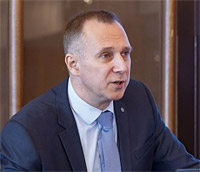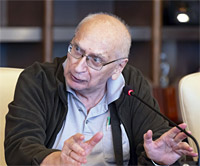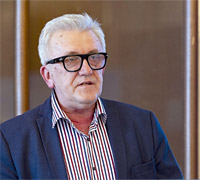
Electronic english version since 2022 |
The newspaper was founded in November 1957
| |
|
Number 26 (4724) |
At PAC meetings
New neutron source needed
The 59th meeting of the Programme Advisory Committee for Condensed Matter Physics was held in a mixed format on 24-25 June. Denes Nagy provided information on the implementation of the recommendations of the 58th meeting of the PAC and Latchesar Kostov provided information on the resolution of the 135th session of the Scientific Council and the latest decisions of the PAC.
 The current state of work on the new neutron source project was the subject of Egor Lychagin's report and Bagdaulet Mukhametuly's report was dedicated to the current plans for resuming the IBR-2 reactor and the user programme.
The current state of work on the new neutron source project was the subject of Egor Lychagin's report and Bagdaulet Mukhametuly's report was dedicated to the current plans for resuming the IBR-2 reactor and the user programme.
"I started my report with history: about how the ideology of creating a new neutron source developed," FLNP Director Egor Lychagin says. "There have been significant changes along the way from 2016 to 2020. We started with a superbooster source - a subcritical assembly of a multiplying material with mechanical reactivity modulation controlled by a proton accelerator. Later, this project evolved into a pulsed reactor based on a new type of neptunium fuel. Today, we have a relatively well-developed proposal from NIKIET regarding this source option. We see that there are technical challenges and it is quite possible that the initially declared high parameters for neutron fluxes, for the intensity of the neutron flux on the surface of the moderators cannot be achieved and these parameters will have to be reduced. There is nothing to worry about, the bar for these parameters was initially set very high. In addition, the Laboratory discusses the proposal of FLNP physicists for a pulsed reactor based on plutonium fuel that has not yet been worked out in detail with NIKIET specialists.

The fundamental problem we currently work on is the issue of reactor stability, no matter what fuel it uses. IBR-2 has a capacity of only 2 MW, we know how it behaves. And the new proposals are reactors with a higher capacity: up to 15 MW on neptunium and 4 MW - a reactor with plutonium that exceeds the parameters of IBR-2. How the reactor will behave, we need to calculate well, to predict, to build mathematical models that is what we do today. We are behind schedule as compared to the original one, but without it we cannot move forward.
Is the issue of extending the operation of IBR-2 considered at the same time?
- Since it is clear that we delay, the issue of the maximum possible operation of IBR-2 becomes increasingly relevant. We have obtained a license from Rostekhnadzor until 2032, we hope that we will perhaps obtain one for another 10 years. It is difficult to say what will happen next: both from the point of view of administrative issues, since licensing involves estimating the condition of the reactor and it was put into operation in 1984. In 2042, the reactor will be almost 60 years old and it is quite possible that the supervisory authorities may simply limit its operation time.
So, there is a critical date when IBR-2 may stop operating and the new source will not yet be developed?
- This situation is always possible. Today, it seems to me, 2042 is the most foreseeable date, it is difficult to look further. And it is already clear that it is very difficult to create a new source by this date. Of course, a break in the transition between sources is not good. We have such a negative experience in our laboratory, when we moved from IBR-30 to the IREN facility; we see what it happens in Gatchina today, when the PWR reactor is shut down and PIK has not yet been launched. This is always associated with some losses, so we would like to make a smooth transition, for example, a gap of two or three years.
- What prompted the appeal in B.Mukhametula's report to members of the PAC to help to attract experts to the committees selecting proposals for experiments?
- This is due to the fact that some countries suspended cooperation with JINR and we had a large group of experts from Germany, Poland, Romania. Maintaining good human relations, it is difficult for people to officially participate in our committees. We turn towards the East: we have already held some consultations with Chinese colleagues and invited them to participate in our committees, negotiations are underway with Kazakhstan and we may discuss contacts with colleagues from India. That is why we address all members of the PAC, since we do not really understand what the situation is like at home, perhaps they can invite someone from their countries.
 The meeting programme included a discussion of the first two reports and P.A.Alekseev (NRC Kurchatov Institute) actively participated in it:
The meeting programme included a discussion of the first two reports and P.A.Alekseev (NRC Kurchatov Institute) actively participated in it:
- The project of a new source is necessary because neutron sources are needed, they are the future, obviously and something should be done in the country for this. JINR is a wonderful platform, since scientists from different countries work here, sharing new ideas and this is very important. And the neutron source is an essential element of the scientific infrastructure of our country.
What kind of source exactly is needed?
- You see, we can do what we can. The original idea was very good, but it was not developed further, it became clear that it would be difficult to implement. We need to implement what is possible and not just what we really want. I mean the spallation source, it is based on proton accelerators, in which each proton with an energy of hundreds of MeV produces dozens of neutrons. It is very effective. If the flash is short, then high neutron fluxes can be obtained at low, compared to reactors, power. In our country, there was an attempt to create such a source in Troitsk, but the project has not yet been implemented. This is complex technology, these are accelerators, they are much more expensive than reactors.
 Member of the PAC A.S.Ivanov (Institut Laue-Langevin, France) also took part in the discussion:
Member of the PAC A.S.Ivanov (Institut Laue-Langevin, France) also took part in the discussion:
- Egor Lychagin in his report spoke about the progress and difficulties on the way of reactor development. Even if the ambitious goals that were set at the beginning may not be completely achieved, nevertheless, a neutron source of this class is necessary for the country. Today, IBR-2 is actually the only operating source. It produces results that are in demand by the scientific community not only of our country, but also of the JINR Member States. One of the comments that I would like to make regarding the instrumentation base of the new reactor is related to the fact that the current reactor has only one spectrometer dedicated to the investigation of inelastic neutron scattering and of the dynamics of molecular systems. We need 30 percent of spectrometers for these investigations that is typical for international sources of a similar type. There are clearly not enough of them at IBR-2, it is desirable to increase the number of devices. We know that development of the instrumentation base is scheduled, there is a project for another facility that will increase the productivity of these scientific investigations, yet probably, we would like to have more such devices. Perhaps, it will be the task of the next meetings of the PAC - to propose and to estimate such projects. The PAC supported the proposal of opening a new project "Highly sensitive sensors operating on the principles of molecular recognition for detecting viruses" that involves specialists from FLNR, MSU, Yerevan State University and institutes of Armenia.
The participant of the project E.G.Zavyalova (Faculty of Chemistry, Moscow State University) is telling about it:
- The topic of our project is to make systems for detecting and possibly, neutralizing viruses. As an object, we chose the African swine fever (ASF) virus that is relevant and quite dangerous for veterinary medicine. It affects large herds of pigs and causes serious economic losses. It is interesting to find this virus at the earliest stages and possibly, to create a means for neutralizing this virus - to extract it from the environment and to stop the infection. For this, we decided to use a combination of methods: physicists from the Laboratory of Nuclear Reactions make track membranes, on which we will plant DNA elements, the so-called aptamers that can recognize viruses among many molecules and bind them. And our Armenian colleagues will help us with biological samples, with testing the technology and will also check whether it is possible to make antiviral agents based on our aptamers to stop the epidemic.
In the future, will your development be used in pig farms?
- Of course, we would like it to be used, it is primarily of interest to large farms - to stop the epidemic in time.
Do you already have any positive experience?
- The technology itself - how to plant an aptamer on a membrane, whether they can stop viruses, we have worked on other objects, on influenza A viruses. We have not worked with the ASF virus yet, we do not have it and for this, we need Armenian colleagues, because they work with it directly, they have accumulated a lot of experience. Why are we confident? We have already made sensors for detecting the influenza virus based on track membranes: we planted aptamers, caught influenza viruses, saw with the help of microscopy that they were successfully caught. A.N.Nechaev (FLNR, Centre for Applied Physics) adds:
 - Since the late 1980s, we have been extensively introducing track membranes into the microbiological analysis of water and air. The main mechanism of isolation was based on the sieve separation mechanism. In the 1980s, we participated in the development of a test system for diagnosing the AIDS virus. The new generation of track membranes is functional, that is, special functional groups are developed on their surface that can specifically capture certain viral particles. And it happens on membranes with a large pore diameter. As part of expanding the applications of track membranes, we are going to carry out this research with our colleagues that is quite important for national security programmes and programmes to preserve the health of the population of Russia and elsewhere. We hope that the JINR Member States, who we will, of course, share the results with, will gradually join our project.
- Since the late 1980s, we have been extensively introducing track membranes into the microbiological analysis of water and air. The main mechanism of isolation was based on the sieve separation mechanism. In the 1980s, we participated in the development of a test system for diagnosing the AIDS virus. The new generation of track membranes is functional, that is, special functional groups are developed on their surface that can specifically capture certain viral particles. And it happens on membranes with a large pore diameter. As part of expanding the applications of track membranes, we are going to carry out this research with our colleagues that is quite important for national security programmes and programmes to preserve the health of the population of Russia and elsewhere. We hope that the JINR Member States, who we will, of course, share the results with, will gradually join our project.
Armenian scientists will implement a range of experiments to study the efficiency and safety of using aptamers to bind to African swine fever viruses. The Laboratory of Antiviral Drugs of the Institute of Molecular Biology of the National Academy of Sciences (Yerevan, Armenia), headed by O.S.Zakaryan, has significant experience in antiviral research, in particular, the ASF virus and some human viruses. Previously, the laboratory identified the efficiency of antiviral agents - flavonoids and, in collaboration with Russian scientists, strict amphipathic fusion inhibitors to combat the ASF virus. The laboratory complies with international biosafety standards of the second level. Within the framework of the current project, the efficiency of specific aptamers for the ASF virus will be studied in vitro cell prototypes. Based on the results of the research, the best candidates will be proposed for testing with artificial track membranes. The new results can have real practical application for controlling the spread of the ASF virus that is a huge problem in Eastern Europe, including Russia and Armenia.
According to R.M.Harutyunyan, the Institute of Biology of Yerevan State University is going to carry out experimental research on the investigation of the genotoxic and cytotoxic effects of DNA aptamers in regular and tumor cell cultures. The Laboratory of General and Molecular Genetics has many years of experience in international cooperation in the field of estimating the effect of environmental mutagens in cell cultures. The Laboratory has previously successfully studied the genotoxic effects of the ASF virus that allowed to estimate the mechanisms of DNA damage caused by this dangerous pathogen. During the project, the main efforts will be aimed at studying the genotoxic effects of aptamers in regular and tumor cell cultures. It is important to note that the genotoxicity of aptamers has not been sufficiently studied and this area is innovative and promising. Aptamers will be tested both in free form and attached to track membranes for recognition and binding of the ASF virus among many molecules. The main objective is to test the possibility of using aptamers to reduce the levels of genetic damage caused by the ASF virus. Postgraduate and master's students will participate in these investigations that will become a good school for them to collaborate with Russian scientists.
All participants of the project are confident that the expected results will contribute to the development of fundamentally new approaches to estimating the possibility and reducing the genetic effects of viral infections.
M.P.Zarubin reported on the progress of work within the TARDISS project, G.A.Kalagov and N.Yu.Samoilova made scientific reports. The papers of young scientists from FLNP, FLNR and LRB were presented at the poster session. Its winners were FLNP employees O.N.Lis with "The impact of high pressure on the crystal, magnetic structure and vibrational spectra of van der Waals compounds", B.A.Bakirov with "Convolutional neural networks for the reconstruction of 3D neutron tomography prototypes from incomplete data" and S.A.Kurakin with "The impact of calcium ions on the structure and morphology of lipid membranes in the occurrence of the Ab (25-35) peptide".
Olga TARANTINA,
photo by Elena PUZYNINA